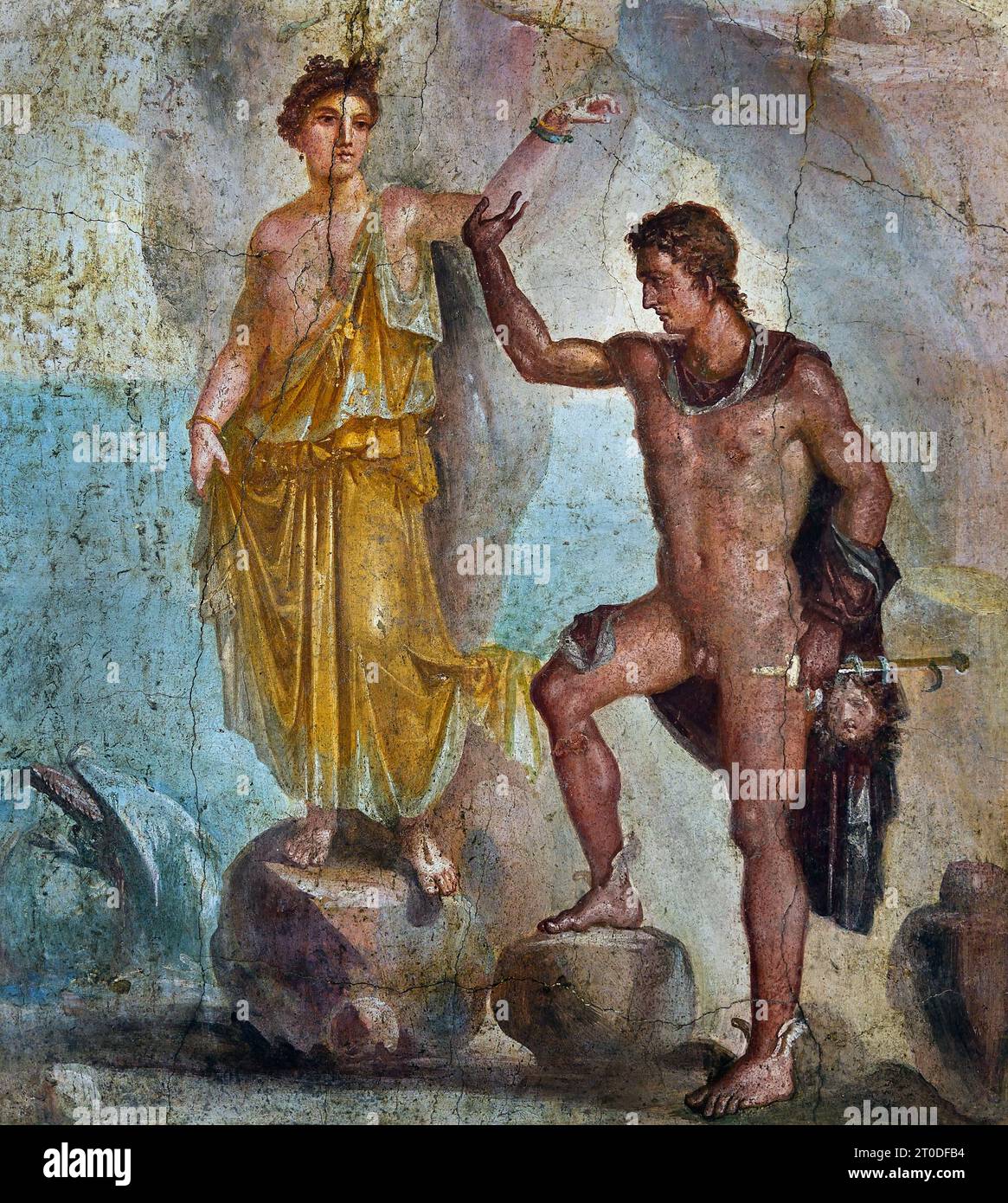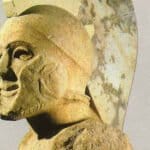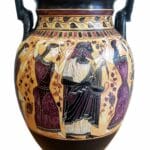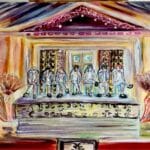A Myth Frozen in Time
Picture this: Pompeii, a vibrant Roman city, frozen in time by the catastrophic eruption of Mount Vesuvius. Among the city’s remarkably preserved ruins are stunning frescoes, offering a captivating glimpse into the daily lives, beliefs, and artistic sensibilities of its inhabitants. One of the most compelling stories depicted in these frescoes is the Greek myth of Perseus and Andromeda—a tale of love, heroism, and divine intervention.
The Story of Perseus and Andromeda: A Roman Obsession?
This epic narrative, popular throughout the Roman world, depicts the beautiful princess Andromeda chained to a rock as a sacrifice to Cetus, a monstrous sea creature sent by the wrathful god Poseidon. Andromeda’s predicament stems from her mother Cassiopeia’s boastful claim that her daughter’s beauty surpassed that of the sea nymphs, a slight Poseidon couldn’t ignore. As Andromeda awaits her grim fate, Perseus, fresh from slaying the Gorgon Medusa, arrives on the scene.
Equipped with winged sandals and armed with Medusa’s severed head, Perseus strikes a bargain with Andromeda’s parents: he will slay the sea monster in exchange for her hand in marriage. Upon seeing Medusa’s head, Cetus turns to stone, and Andromeda is saved. Perseus, true to his word (and likely captivated by Andromeda’s beauty), marries her, beginning their life together. You can learn more about legendary figures like Helen, the Spartan queen of myth, to further explore the world of ancient heroes and heroines.
The prevalence of the Perseus and Andromeda myth in Pompeii, evidenced by at least five known frescoes depicting the story, suggests its significant resonance with the city’s residents. It’s easy to see why: the story combines adventure, romance, and a triumphant ending, elements that likely captivated audiences then as they do now.
Variations on a Theme: Pompeii’s Artistic Interpretations
The most iconic of these frescoes, originally found in the opulent House of the Dioscuri, is now housed in the National Archaeological Museum in Naples. This masterpiece showcases Andromeda chained to the rock, fear etched on her face, while Perseus, poised and heroic, battles the monstrous Cetus above. Other depictions, though sometimes fragmented by the passage of time, offer unique variations on the tale, further highlighting the artistic license and interpretations favored by Pompeii’s artists. In the House of the Vettii, for example, tantalizing traces of the couple remain, teasing researchers and sparking further investigation.
These frescoes weren’t merely decorative; they functioned as visual narratives, much like ancient “comic books,” bringing beloved myths to life and serving as a testament to the cultural values and artistic preferences of the Pompeiians.
Delving Deeper: The Nuances of a Myth
A Deeper Dive into Andromeda’s Plight
Andromeda’s predicament wasn’t just a monster story; it reflects the often precarious position of women in the ancient world. Used as a pawn in a divine power struggle, Andromeda’s fate was decided by others. Her story may resonate with modern audiences who recognize themes of political maneuvering and the exploitation of women throughout history.
Perseus: Hero or Opportunist?
Perseus’s heroic rescue, while undoubtedly brave, also involved a calculated bargain. Was his motivation purely altruistic, or did the prospect of marrying a princess contribute to his daring act? This ambiguity adds depth to Perseus’ character, highlighting the complexities of heroism and self-interest.
The Myth’s Enduring Appeal
The myth’s enduring appeal likely stems from its exploration of universal themes: sacrifice, divine wrath, and the transformative power of love. It reminds us that even gods can hold grudges (perhaps a cautionary tale against boasting!), and that love can blossom in the most unexpected circumstances.
Beyond the Happy Ending: What Became of Perseus and Andromeda?
The myth traditionally concludes with Perseus and Andromeda’s marriage, but their story doesn’t end there. Different versions of the myth offer varying accounts of their later lives and deaths. Some suggest a peaceful end, ruling wisely and justly until old age. Others, perhaps more romantically, depict their ascension into the heavens as constellations, forever memorialized in the night sky. This lack of a single, definitive narrative provides fertile ground for discussion and highlights the evolving nature of myths and their interpretations. The proximity of the constellations associated with Perseus, Andromeda, Cepheus, Cassiopeia, and Cetus suggests a celestial tableau, forever narrating their intertwined destinies.
Ongoing research continues to unravel the mysteries surrounding these mythological figures. This ongoing exploration invites us to engage with these ancient stories, not as static historical accounts, but as dynamic narratives that continue to resonate with audiences today.
Locating the Legend: The House of the Dioscuri and Beyond
The most famous Perseus and Andromeda fresco hails from the House of the Dioscuri in Pompeii, named after the prominent frescoes of Castor and Pollux that graced its entrance. This luxurious residence offers valuable insights into the lifestyle of a wealthy Roman family. The prominent placement of the fresco suggests its importance within the household, perhaps serving as a conversation piece, a status symbol, and a testament to the owner’s appreciation of Greek mythology and artistic expression.
The fresco’s vibrant colors, dynamic composition, and meticulous details, including Perseus’s winged sandals and Andromeda’s chained figure, highlight the skill and artistry of the Roman painter. Whether this fresco was a copy of an earlier Greek masterpiece or a unique Roman interpretation remains a subject of ongoing scholarly debate.
The fresco’s present location, the National Archaeological Museum of Naples, allows art enthusiasts and scholars alike to continue studying this piece, connecting with the past and appreciating the artistic and cultural legacies of Pompeii. It serves as a poignant reminder of the city’s vibrant life before the eruption and the enduring power of art to transcend time and tragedy.
- Unlock Filipino Culture: A Deep Dive into Traditions and Practices - April 23, 2025
- Unlock Spanish Culture: Insights & Opportunities Now - April 23, 2025
- White Spirit Uses & Substitutes: A Deep Dive for Pros & DIYers - April 23, 2025

















1 thought on “Here are a few title options that incorporate your keywords and the context of your competitors, while aiming for a unique and engaging spin:Options that emphasize visual aspects and location:Perseus and Andromeda: A Pompeii Love Story in Frescoes (Adds a touch of romance and intrigue) Pompeii’s Walls Whisper: The Myth of Perseus and Andromeda in Fresco (More poetic and evocative)Options highlighting multiple locations and deeper exploration:Beyond the House of the Dioscuri: Tracing Perseus and Andromeda Across Pompeii’s Walls (Action-oriented and emphasizes the scope) Pompeii’s Painted Myths: Unmasking the Many Faces of Perseus and Andromeda (Focuses on the variety of depictions)Options emphasizing history and preservation:Frozen in Ash: The Enduring Myth of Perseus and Andromeda in Pompeii (Dramatic and highlights the impact of Pompeii) Before Vesuvius: Perseus and Andromeda, A Love Story Immortalized in Pompeii (Combines romance with the historical context)For SEO purposes and current trends, consider these factors:Shorter titles often perform better on search engine results pages (SERPs). Including Pompeii early in the title can help with keyword relevance.Ultimately, the best title will depend on your target audience and the overall tone you want to convey.”
Comments are closed.